Different Types of Houses Pictures and Information
When it's time to go house-hunting, home buyers are faced with a wide variety of different types of houses to consider. The final choice will depend on budget, taste and family requirements, however, it pays to peruse the types of houses available, from multifamily options to single-family homes.
Take a look at these various styles of homes and see what types might fit your needs — some will likely surprise you!
Condominium

High-rise buildings often house condos rather than apartments.
A condominium differs from other types of houses because it is one unit in a building or a separate building among many on a specific tract of land. Unlike an apartment, a condo is purchased and not rented, with each owner holding title to the residence, whether it's in a high-rise building or a separate building.
Condominiums are governed by a board that is elected by the residents that oversee the overall property and make rules and decisions about maintenance and the operation of the community.
In high-rise buildings, condo units can occupy one floor, two or even three. Other types of condos can be townhouses or other style units.
According to Nationwide Insurance, condominiums often focus on a community and include a clubhouse or common areas, pool, gym, and other amenities. Of course, while residents enjoy a care-free life and don't have to care for the common areas, they do have to pay Home Owners Association fees for the upkeep of the common areas and the buildings.
These monthly fees can range from $100 to more than $1,000 a month. That said, depending on the neighborhood and the nature of the property, these types of homes will cost less than a single-family detached house in the same area.
Distinctive type Modern Apartment Style
 View in gallery View in gallery
View in gallery View in gallery 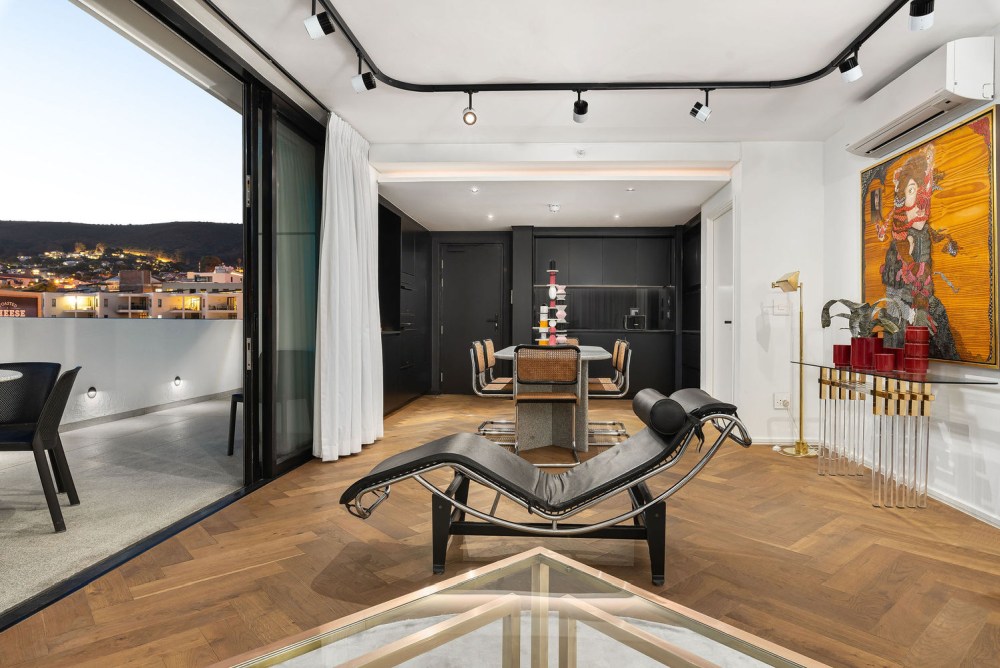 View in gallery View in gallery
View in gallery View in gallery  View in gallery View in gallery
View in gallery View in gallery  View in gallery View in gallery
View in gallery View in gallery The term "apartment building" often brings to mind a boring block structure but architects like Robert Silke & Partners of Cape Town, South Africa are rising to the challenge of creating visually distinctive and modern residential buildings. A great example is their Tuynhuys, which is a new block of 47 apartments in Cape Town's old city legal district. It has a very playful, futuristic look that was designed to fit into this stoic row of Victorian and Cape Dutch commercial buildings in a sensitive historic locations.
The curvy exterior has a sculptural appeal that manages incorporate the DNA of all its neighbors without mimicking their historic look. Inside, the apartments have clean lines and a modern aesthetic that plays on the architectural elements, such as the round windows and curved walls.
Apartment

Apartment buildings can offer trendy design details on the exterior.
The key difference between apartments and other types of houses is that apartments are rental units and are typically not purchased. In larger buildings, apartments are typically owned by a single entity.
According to the Apartment Guide, apartment complexes have maintenance and other staff on-call to handle things that break or stop working. These communities also offer amenities such as gyms, pools, party rooms tennis courts and other perks on site.
Of course, the other side of the coin is that all the apartment look the same and resident generally cannot make major changes to the unit. In addition, most of the finishes, hardware and detailing will be generic and not as upscale as you could have in a condo or house.
Custom Extended Family Co-op
 View in gallery View in gallery
View in gallery View in gallery  View in gallery View in gallery
View in gallery View in gallery A co-op typically has members that support its maintenance and functioning, but this modern structure in the Achumani valley of La Paz, Bolivia takes that a step further: The eight-apartment building was designed to suit the diverse desires and means of three generations of a single family. Designers Christian Dávila Arquitectos created the simple structure using reinforced concrete in a way that keeps costs low, and sets up optimal conditions for natural light and ventilation in each of the residences. The resulting co-op building offers up views of the mountainous landscape and has numerous terraces, which a basically a must-have for the climate. The building is also protected from the street by a gated wall, configured in an urban and most unobtrusive way possible.
Inside, some areas were left with basic concrete flooring so that the resident could personalize the space. Built-in storage and furniture elements serve as internal dividers instead of walls in some areas and large windows help give the different spaces an open, airy and light-filled quality.
Co-op

A co-op is physically a lot like an apartment or condominium.
A co-op physically looks the same as a condo or an apartment, but the real difference comes in the legal and financial side of the equation. In a co-op, the co-op members are essentially shareholders in the building.
They don't technically own a specific unit, but are leasing it from the co-op. Purchasing a home in a co-op can be a little more challenging in that the building's board or association vets each prospective buyer, putting them through a rigorous screening that sometimes seems like an invasion of privacy. Also, according to TheBalance.com, not every bank will make a co-op loan and not every coop qualifies.
A co-op is often cheaper to buy than a condo, but the fees may be higher than those in a comparable condominium. Those fees cover a portion of the building's mortgage, salaries for doormen, maintenance staff, possibly a building superintendent; insurance; regular maintenance, cleaning of common areas, and real property taxes.
Townhome
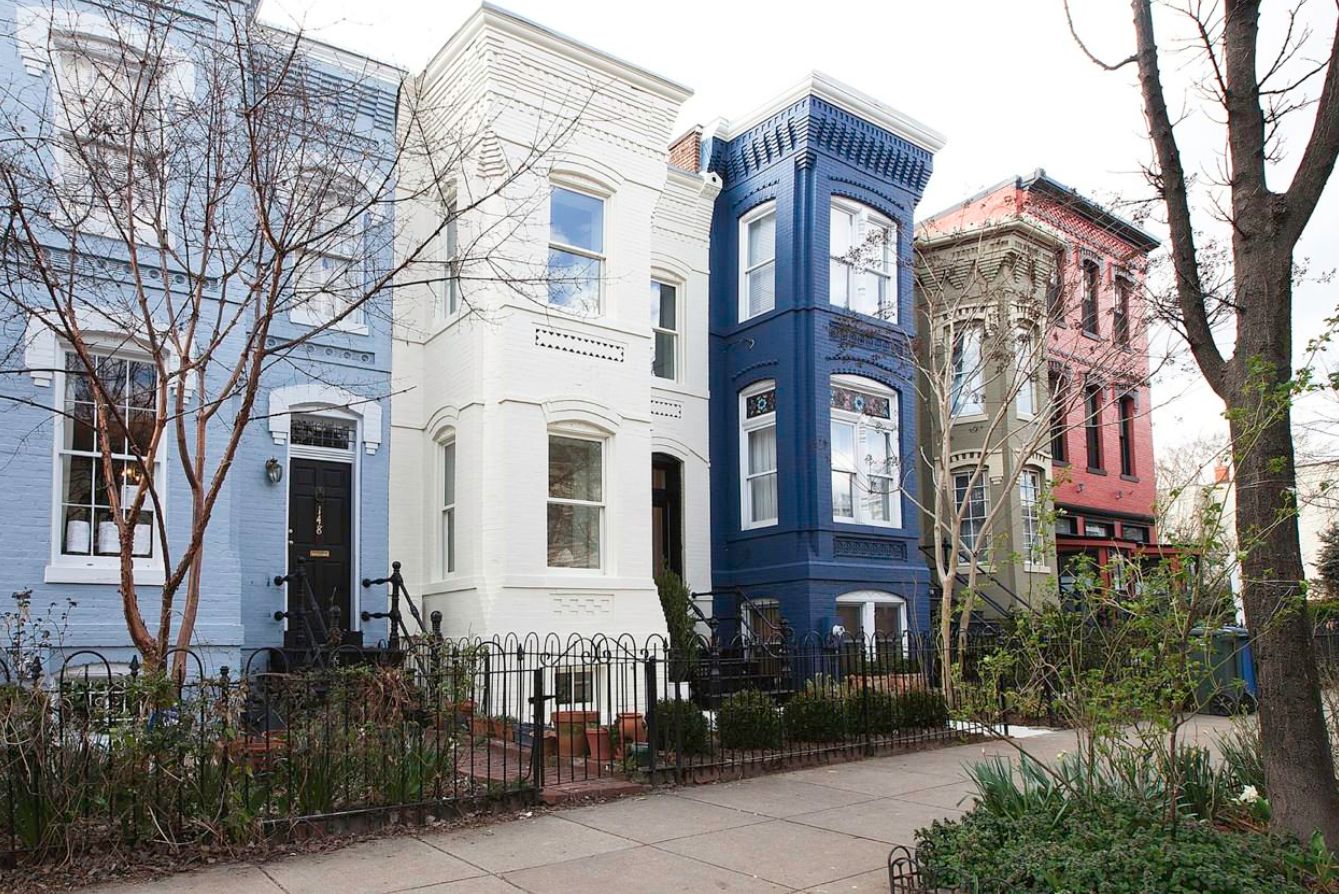
City townhomes often have more individual character than planned townhome communities.
According to Realtor.com, a townhouse is typically a single family home that is sandwiched between or next to other homes just like it. Sometimes called row houses, townhomes share side walls and are often quite uniform, generally have two or three floors. Unlike condos, residents own the interior and the exterior of their homes including any yard that comes with the house.
These types of houses also have a homeowners association to cover any shared maintenance costs, such as things like trash removal and snow plowing. The associations also have rules about elements like exterior paint colors, fences and the like.
Urban Townhome With Single-Family Flair
 View in gallery View in gallery
View in gallery View in gallery Townhomes offer the best blend of city living and suburban privacy. Located in Denver, Colorado, this trio of townhomes by Meridian 105 Architecture sits in the popular Lower Highlands (Lohi) neighborhood, surrounded by a mix of single family homes, commercial buildings, and large apartment blocks.
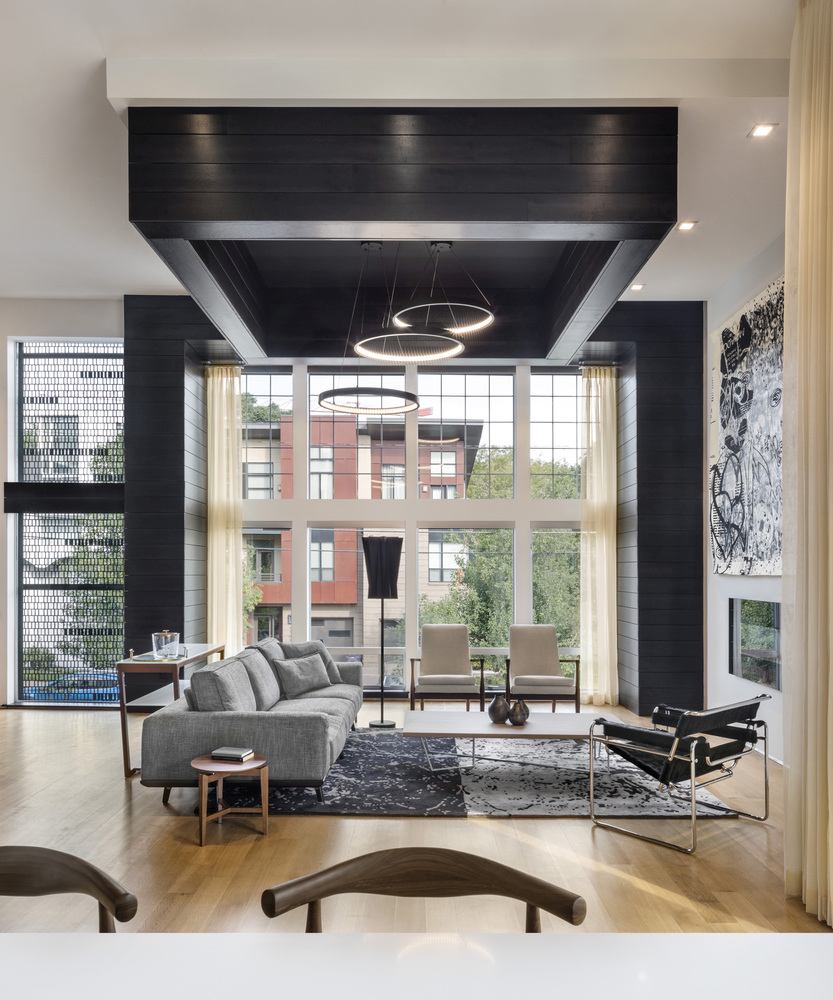 View in gallery View in gallery
View in gallery View in gallery  View in gallery View in gallery
View in gallery View in gallery Each of the three residences in the structure are 3-stories in height, topped off by a covetable fourth story rooftop deck. The heavy looking façade keeps pace visually with the larger buildings in the area but the materials used – along with the contrasting black and white theme — add interest and a finer touch to the townhome. Small voids on the side of the building enclose outdoor patios.
 View in gallery View in gallery
View in gallery View in gallery The interior space features clean lines, tall ceilings and some outstanding architectural details that help frame the view out the window and add a major focal point to the main living space. A modern kitchen features sleek cabinetry and a waterfall-style island with counter seating.
Ranch-Style Home

Ranch homes became popular as the suburbs grew.
A ranch style home is a single-story house that has its origins in Spanish hacienda. As the suburbs grew in the 1950's these types of homes gained popularity thanks to the wide-open spaces. According to Angie's List, a ranch is usually found in a rectangular or L or U shape with an open, casual layout.
With a long and low profile, SFGate says that these homes have typically extended eaves and a low-pitched roof, along with an attached garage. The most common types of ranch homes are built with brick, wood or stucco.
Many are built on a concrete slab, especially those in California or the Southwest, while others have a crawlspace or full basement. Inside, the floor plan of a ranch is open and flowing and generally has large windows, including sliding glass doors that lead out to a patio.
Western Ranch Style
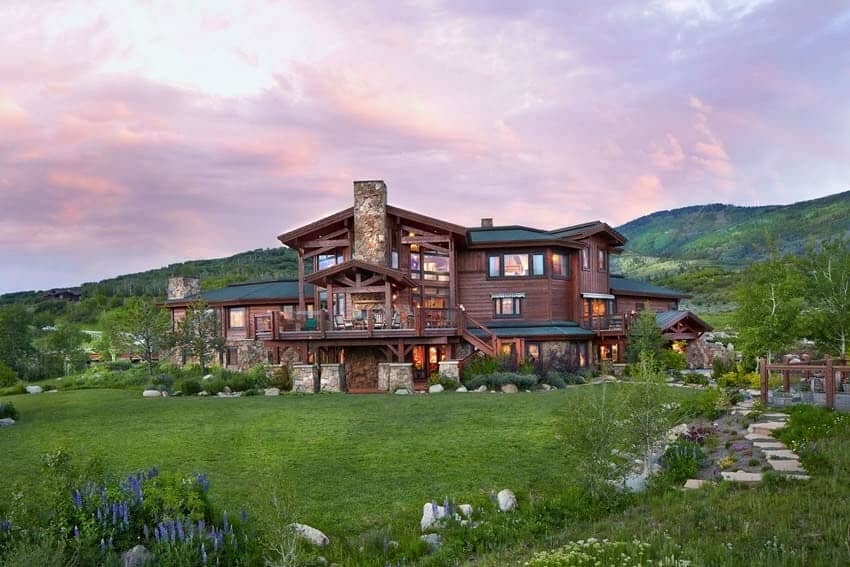 View in gallery View in gallery
View in gallery View in gallery With this kind of ranch style, we're not talking about the single-level suburban homes that you might think of. This kind of ranch can be any number of stories and has a style typical of those found in the Western United States.
 View in gallery View in gallery
View in gallery View in gallery This gorgeous ranch commands mountain views over its 36-acre plot near Steamboat Springs, Colorado. Created by architect Joe Robbins, the 9,245 square feet of living space have a relaxed and appropriately rustic décor style.
 View in gallery View in gallery
View in gallery View in gallery  View in gallery View in gallery
View in gallery View in gallery The home's five bedrooms and four-and-a-half bathrooms – as well as its spacious communal areas — feature numerous fireplaces, plenty of stone, rough-hewn beams and, of course, huge windows to soak in the views. Despite its rustic style, the vibe is one of pure relaxed outdoor-focused luxury.
Bungalow

A bungalow is typically one story tall, perhaps one and a half.
A small, square, single-story house with a front porch is generally called a bungalow. The name comes from India, says Antique Home Style, where small "bangla" huts were used for travelers. The English then took the style and adapted it to their needs, including covered verandas and open floor plans.
SF Gate writes that they became popular in the Northeast US starting around 1900. Typically with this type of house the floor is raised up and front steps are needed.
These types of small houses became less popular as the desire for larger and larger homes took hold. The interior of a bungalow is very efficient with space as closets are small and there are usually built-in cabinets and shelving. Their smaller size makes them ideal for couples, singles, and those who want to downsize their lives.
A Restored Spanish-Style Bungalow

Bungalows are always highly sought after, however those that become available are often sorely in need of modernization and an upgrade in style. That's exactly what Byrdesign was facing with the renovation of a 1920s Spanish-style bungalow in Venice Beach, California.
 View in gallery View in gallery
View in gallery View in gallery As is often the case, earlier remodeling projects had stripped the home of any character as well as its Spanish-style roots. So, the architects stripped the house to its studs and re-imagined it with a design that features Spanish arches, stucco walls, exposed wood beams, a colorful talavera tile
 View in gallery View in gallery
View in gallery View in gallery  View in gallery View in gallery
View in gallery View in gallery A new floor plan improved flow, added storage such a master walk-in closet and loads of built-ins that were characteristic of the original era. The connection with the outdoors was also improved with the addition of a kitchen that can open up to the patio, which also creates the benefit of added natural light. An outdoor shower is also a luxurious and convenient option for the surfing enthusiast who lives here.
Carriage/Coach House

A carriage house is a secondary building on a property.
Originating as a two-story building to house horses with the caretaker's quarters above, carriage houses were popular in the Northeastern United States, says Realtor.com. Today's carriage houses, however, are either older renovated buildings or modern ones built in the old style.
In fact today these types of houses are a bonus, secondary to the main house, and used for in-law apartments, home offices, art studios and the like.
There is a difference, however, between a carriage house and a carriage home, the website says. A carriage house is a secondary building on the property while a carriage home is a single-family home that is similar to a townhouse. These can also be called a zero-lot-line home or patio home.
Multi-Family

Mutlifamily homes allow owners to rent out part of the home.
Multi-family homes are just that –-properties with more than one unit that can serve as home to more than one family. These can be apartments, duplexes, or triplexes, few. According to Mashvisor, the main reason people invest in these is to defray the cost of their own housing.
By renting out the unoccupied portion, homeowners can afford to have their own place. Those interested in living in and managing these types of houses have to consider the possibility of vacancies, dealing with renters and managing the maintenance of another person's home, along with additional insurance considerations.
Custom Multifamily Focused on Views
 View in gallery View in gallery
View in gallery View in gallery Today's multifamily houses can have amazing style as demonstrated by this home – named Caspärsch — in Jenins, Switzerland near the Rhine Valley. Schwabe Suter Architekten devised this The distorted rectangular shape of the building houses two apartments and one duplex-apartment, all stacked horizontally layered.
 View in gallery View in gallery
View in gallery View in gallery Each one is divided into a private sleeping area and a more public living area. The kitchen, dining area, living room and entryway feature an open plan that surrounds the spacious balcony space. Throughout the exterior facade, certain elements are a nod to the village's traditions, such as the plaster finish and embellishments that include motifs from old handicrafts.
Contemporary Mansion

Contemporary mansions are all about the amenities.
The term mansion might conjure up visions of grandeur, but it's hard to define what those have to be. Realtor.com says that there is no rule regarding what square footage qualifies a home as a mansion, but it is generally over 5,000 square feet, while some realtors maintain it needs at least 8,000 square feet.
More than just lots of square feet – and numerous bedrooms and bathrooms — contemporary mansions must have plenty of luxury amenities. These include entertainment and relaxation facilities like high-tech media rooms, pools, bars, wine cellars, cigar rooms, cabanas, gyms and catering kitchens.
The closets have to be large and spacious and the security systems top notch. Also, the materials used to construct all those elements have to be top of the line, as do all the appliances in these types of houses.
Historic Mansion
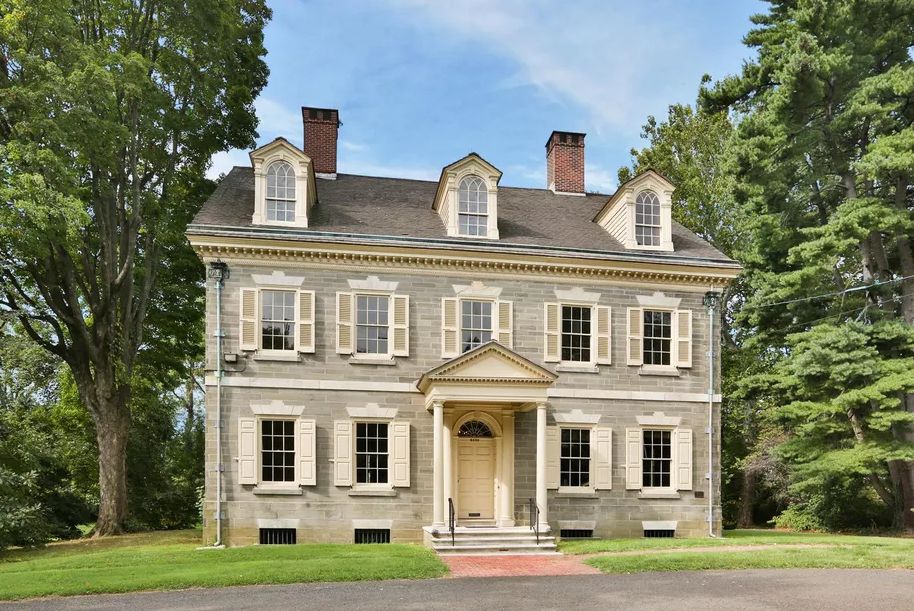
Historic homes must be officially designated as such.
The term "mansion" is said by dictionaries to be derived "through Old French from the Latin wordmansio", an abstract noun derived from the verbmanere to dwell. In order for a mansion to be historic, it has to be more than just big and a little old. This type of house has to be listed by an official body as "historic."
This means it has to meet certain criteria with regard to age, preserved condition, and historical significance. These types of homes are hard to come by and are typically named, either according to the original family or the historical event that defines it.
English Cottage

Construction of a cantilevered glass extension to a period property by Stephen Marshall Architects
Most English cottages are immediately recognizable thanks to the exterior characteristics of a steeply pitched roof and cross-gables, large stone or brick chimneys often, and small-paned bands of casement windows.
Antique Home Style says that entryways are commonly front-facing gables and the roof is a catslide, which is steep and straight on one side and curved on the other. English cottages are generally asymmetrical and often have a thatched roof.
The exterior is usually done in brick, stucco, stone, or wood. Inside, the rooms are small, cozy and compartmentalized — not the open plan style found in many other types of houses.
Quintessential English Cottage
 View in gallery View in gallery
View in gallery View in gallery This English cottage is named "Elysian" for good reason: It has all the charming and cozy elements that define a true English cottage. Located in Rilla Mill in Cornwall, UK, it is full of a charm and an old-style lux vibe thanks to things a wood-burning stove fireplace and the updated cottage-style furnishings that are true to the genre but with upgrade coziness.
 View in gallery View in gallery
View in gallery View in gallery  View in gallery View in gallery
View in gallery View in gallery Throughout the home, whitewashed walls create a serene space and accents like rustic beams in the living room and an eclectic kitchen with pastel green cabinetry add extra charm. Three upstairs bedrooms feature blackened floorboards and low ceilings whole the bathroom done in a refreshed vintage style. The biggest draw of a cottage style home like this one may actually be the exterior: aesthetic, offering views through the traditional hand-crafted wooden windows and out to the spectacular gardens.
Cabin

A cabin is usually a simple structure in the woods or near a lake or river.
Synonymous with a secluded getaway, the term cabin can mean many things. These types of houses have traditionally been small, modest structures. That said, today they can be chock full of amenities and as luxurious as a full-time house.
Cabins may also be called cottages or camps, all depending on what part of the US you are in. The one thing they all have in common is their rural location in the woods and often by a lake or river.
In the past, cabins were often built with logs or timber, but these days, they can be constructed of just about any kind of building material.
These types of houses are usually one, or one and a half stories tall and are simpler and more rustic than a traditional home
Modernized Midcentury Style Cabin
 View in gallery View in gallery
View in gallery View in gallery  View in gallery View in gallery
View in gallery View in gallery It has all the ease of a typical cabin type home and a mountain location to boot, but this unique design is all mid-century modern through and through. Johnston Architects created a design-forward home that capitalizes on the location of this home, perched on a mountainside above the river in the Methow Valley of Washington state.
 View in gallery View in gallery
View in gallery View in gallery  View in gallery View in gallery
View in gallery View in gallery This property offers up great view and privacy, but to have both, the architects went with an "L" shaped plan that orients both ends toward the views. This created an inside corner, perfect to sheltered patio. Rusty steel was used on facade while the sides that are less affected by the elements are clad with cedar.
 View in gallery View in gallery
View in gallery View in gallery The furnishings and décor throughout the home are midcentury modern with modern twists, all done with relaxation in mind. A few things recall the typical simple cabin style, such as wood ceilings and beams, but in this case the beams are of a more modern kind.
Chalet

A chalet is ideal for an area that gets a lot of snow.
The term chalet calls up images of an idyllic Alpine location and actually refers to a house built from wood with a substantial, sloping roof and wide eaves at the sides of the house.
The architectural style is well suited to hillsides and areas with plentiful snow. These types of houses have the air of being hand-crafted in a world full of mass-produced home strictures, notes All Things Stone.
Chalet style homes originated in the Swiss Alps, where animal herders used them, but over time they became popular in many countries, especially as places for a wintertime getaway. Some of the features that make them so popular are the single-gable silhouette, dominance of wood on the exterior, front balconies and big windows ideal for gazing at the snow-covered landscape outside.
The interior of a chalet is focused around the open floor plan and high ceilings, which beings everyone to gather in the heart of the home.
Luxury Mountain Chalet
 View in gallery View in gallery
View in gallery View in gallery While the characteristic image of a chalet style home is probably a cute alpine version, this luxury mountain chalet design has modern style galore. Featuring big windows for enjoying the mountain views in in Big Sky, Montana, this Rocky Mountain home is also very energy-efficient. Designed by Reid Smith Architects, this spectacular residence was created with a clean-lined contemporary style and executed in luxurious materials and finishes.
 View in gallery View in gallery
View in gallery View in gallery 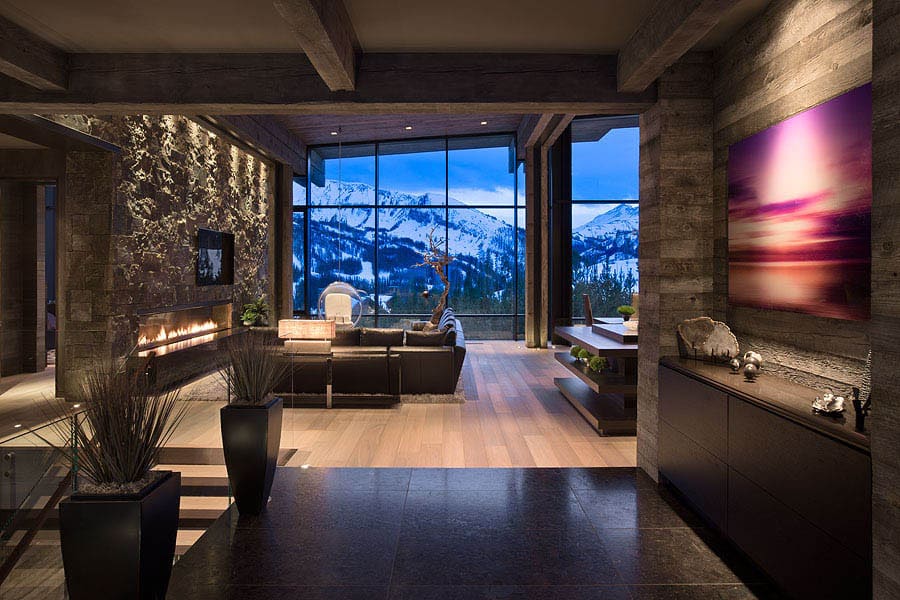 View in gallery View in gallery
View in gallery View in gallery  View in gallery View in gallery
View in gallery View in gallery  View in gallery View in gallery
View in gallery View in gallery The main living area includes floor-to-ceiling glass walls that put the mountain views center stage. The open-plan space is ideal for family time as well as for entertaining. The master bedroom also has glass walls so every morning wakes you up with a view. Beautiful design, luxe but relaxed interiors and the one-of-a-kind views make this mountain chalet a house even snow-haters will adore.
Castle

True castles were constructed primarily for protection.
A castle is actually a fortified structure that originated in the Middle Ages, built for noble or royal families. While castles were fortifications built around the world to defend territories, there really aren't any in the United States, writes the New York Times.
Interest in castles has been piqued recently thanks to popular television shoes like Harry Potter, Game of Thrones and Downton Abbey, however, unless you likely don't want to live in a real one – not without significant upgrades.
In the United States, any castles being built are fantasy structures, the paper says. Buying an existing castle of any size is a big commitment to renovation and maintenance, as most are lacking in the creature comforts most people come to expect and are functionally challenging in many ways, such as with kitchens in the basement and less than optimal plumbing.
Abandoned Castle With New Life
 View in gallery View in gallery
View in gallery View in gallery Having lived previous lives as a fortified royal manor, a hotel and then a ruined curiosity, Astley castle can now serve as a home. Owned by preservation charity the Landmark Trust, the abandoned castle in Nuneaton, Warwickshire, UK has been restored and reimagined as a fully habitable residence – with running water, a soaking tub and comfy beds.
 View in gallery View in gallery
View in gallery View in gallery Through a competition, Witherford Watson Mann Architects were selected to carry out their unique plan for renovating the residence and moat, entry gateway, curtain walls, lake, church, and what was left of the Elizabethan era pleasure gardens.
 View in gallery View in gallery
View in gallery View in gallery The strategy was to recreate the spaces as they had been used historically, keeping as of the original feel as possible. New construction was fused with old masonry elements following the uneven joints, creating a fascinating look. The spacious residence has clean lines and modern elements such as an open stairway, minimalist kitchen and cozy bedrooms that are focused on the original exposed exterior walls.
Chateau

A chateau is generally a palace or large country house.
Expansive lawns, manicured gardens and a massive stately residence come to mind when someone mentions the word chateau. The French term is actually translated as "castle" but is usually used to describe what most would also call a palace or large country house, according to My French House.
Originating in the 13th and 14th centuries the name came to mean a substantial country house. As Britannica.com says, these types of houses became "spacious yet still-fortified private residences of the nobility."
Similar to purchasing an old castle, a European chateau is a financial commitment to constant upkeep and maintenance, both inside and out, thanks to the size and age of most chateaux.
Old World Chateau With Modern Comforts
 View in gallery View in gallery
View in gallery View in gallery It turns out that there's no need to move to France if you want to live in a chateau. Modern versions that are inspired by old world style feature far more creature comforts than the draft originals. This custom designed chateau style home is on the shores of Lake Minnetonka's Crystal Bay just outside of Minneapolis, Minnesota. The massive 13,000-square-foot was created by Sharratt Design and features a family-friendly fresh and sophisticated home informed by elements of traditional chateau style.
 View in gallery View in gallery
View in gallery View in gallery  View in gallery View in gallery
View in gallery View in gallery  View in gallery View in gallery
View in gallery View in gallery Plenty of floor-to-ceiling windows open up the view to the lake. With spaces such as an Old World wine cellar, a bar and sports court, there are also lots of places for adults to play. Kids of all ages will enjoy the a 16-foot "wall of fire" on the outdoor patio. Throughout the home, luxe details like fireplace embellishments tie the main style into the more contemporary spaces. It even features an upstairs master suite along with a junior suite on the main level, as well as a guest room that incorporates Universal Design for aging in place.
Palace

Built in the 13th century, Beaulieu Palace House was the gatehouse of Beaulieu Abbey.
Unlike a castle or chateau, a palace is built specifically to be luxurious, spacious and comfortable. Palaces arose as grand homes for heads of state and dignitaries, hence their large halls and spacious rooms.
The aim behind these stately types of houses is to display wealth and opulence with their size, beauty and high-end materials. They are symbolic with a leisurely life and wealth.
Indulge Your Palace Dreams
 View in gallery View in gallery
View in gallery View in gallery When it comes to palaces, you can do more than dream about living in one – you can now say in one! Located in Jaco, Costa Rica, 250 feet above the Gulf of Nicoya, the Zephyr Palace opens up royalty level luxury to all its guests A luxury boutique hotel, it has its own private beach, and seven themed suites that transport you to another era of luxury.
 View in gallery View in gallery
View in gallery View in gallery Amenities like an art gallery, gourmet cuisine, infinity swimming pool, plunge pool, and Jacuzzi, are all set amid a tropical rain forest. Some of the exterior colors and architectural elements bring to mind the palace in Sintra, Portugal. Staying at the Zephyr Palace is better than owning one: All the enjoyment with none of the maintenance.
Villa
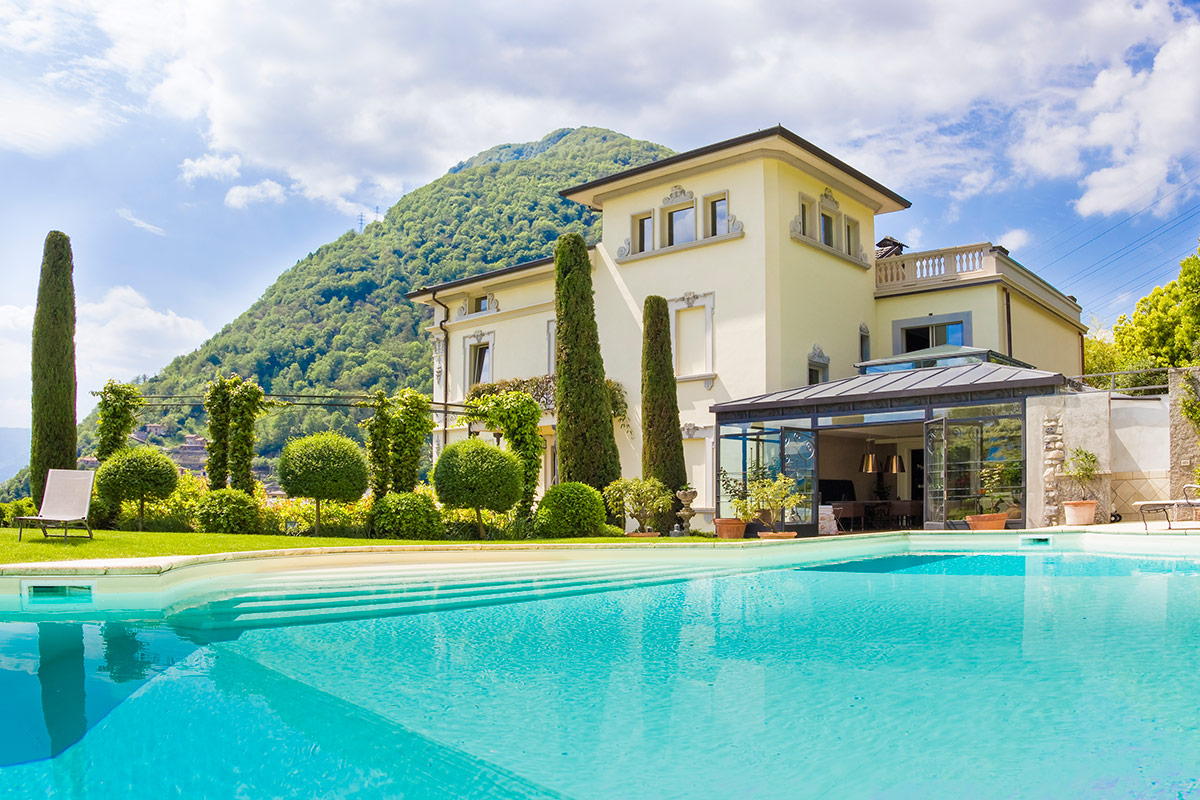
A villa typically has gardens, extensive grounds or even a vineyard attached to it.
Technically, a villa can be similar to a regular single-family home but is actually known for being a larger, more luxurious residence. These types of houses often have gardens, vineyards fountains or courtyards.
Villas can have up to 20 bedrooms and typically have a more luxurious feel to them. Villas certainly have the cachet of a private retreat, no matter what their size, and are generally associated with European or tropical locales.
In the United States, some planned communities also have units called villas, which are like apartments or condos, as do some hotels.
Villa in the Pacific Palisades
 View in gallery View in gallery
View in gallery View in gallery Located in the Pacific Palisades neighborhood of Los Angeles, California, this villa has a modernist style but still maintains the easy feel that is synonymous with the design genre. O+ L Building Projects designed the 8,273-square-foot family-friendly home in partnership with Gunderson Matkins.
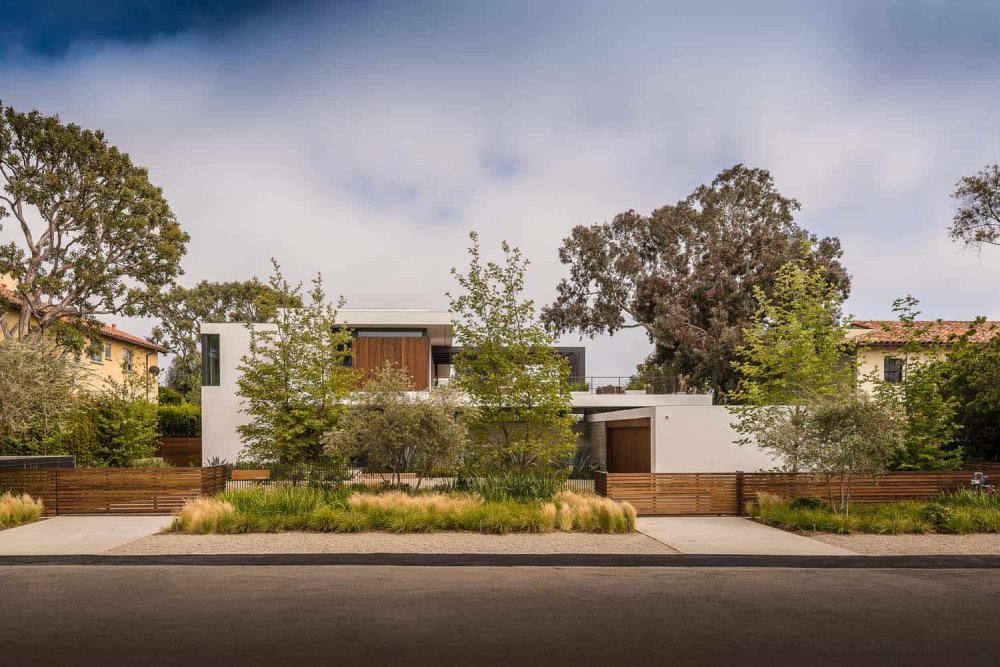 View in gallery View in gallery
View in gallery View in gallery The sprawling house is oriented toward its ocean and golf course views, using a Z-shaped design to separate the private part of the home from the more public living spaces. Inside the look is open and airy with modernist décor and a luxuriously easy feel throughout.
 View in gallery View in gallery
View in gallery View in gallery 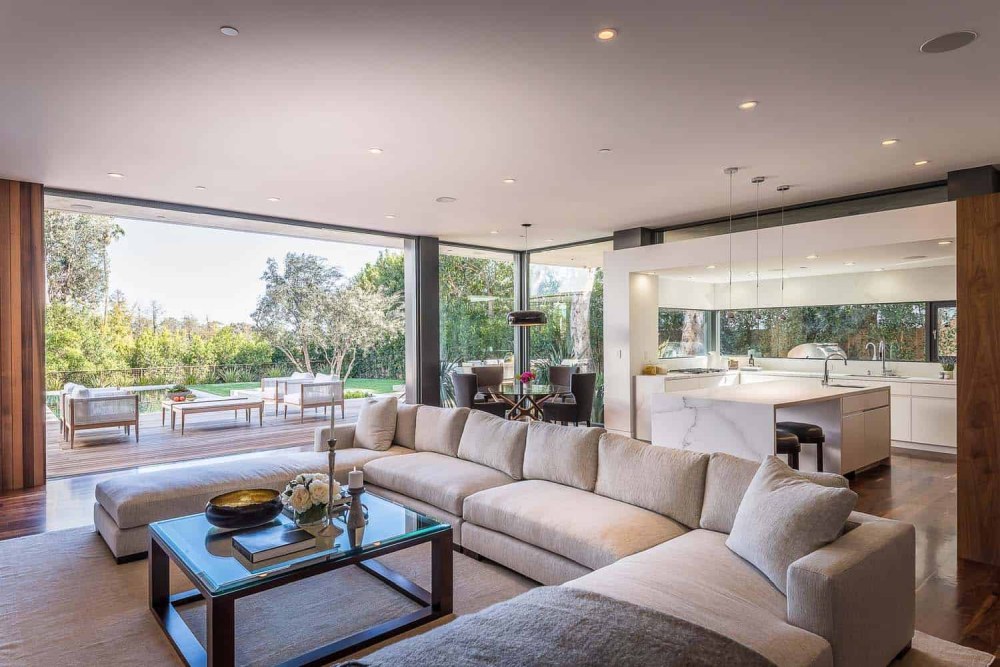 View in gallery View in gallery
View in gallery View in gallery Punctuated by areas clad in wood and highlighted by raw concrete walls. In addition to the six bedroom/bathroom suites, the home also features a maid's quarters, full guest suite and a spacious master bedroom suite, complete with with his and her baths and a sitting area. A gym with its own patio, a wine cellar and a home theater for 12 are located in the fully finished basement.
Manor House

Manor houses can be large and grand or quite modest.
A manor house is essentially a country house that has land associated with it. Historically, it was the principal house of a landed estate, according to Castles and Manor Houses.
Similar to a mansion, the term manor house is more commonly used in the UK, where it is associated with an estate that encompasses fields, woods and sometimes other buildings. Collectively, the entire package is called a manor.
The term manor house has become associated with spaciousness but not all display largesse and some can be quite modest.
The Manor Reimagined
 View in gallery View in gallery
View in gallery View in gallery With a stately new look on the exterior this English manor house near Houston, Texas has n an interior that is pure old world luxury. The 10,000-square-foot residence is rife with luxurious detailing like grand archways, beamed ceilings, paneled walls and plenty of stone elements.
 View in gallery View in gallery
View in gallery View in gallery  View in gallery View in gallery
View in gallery View in gallery 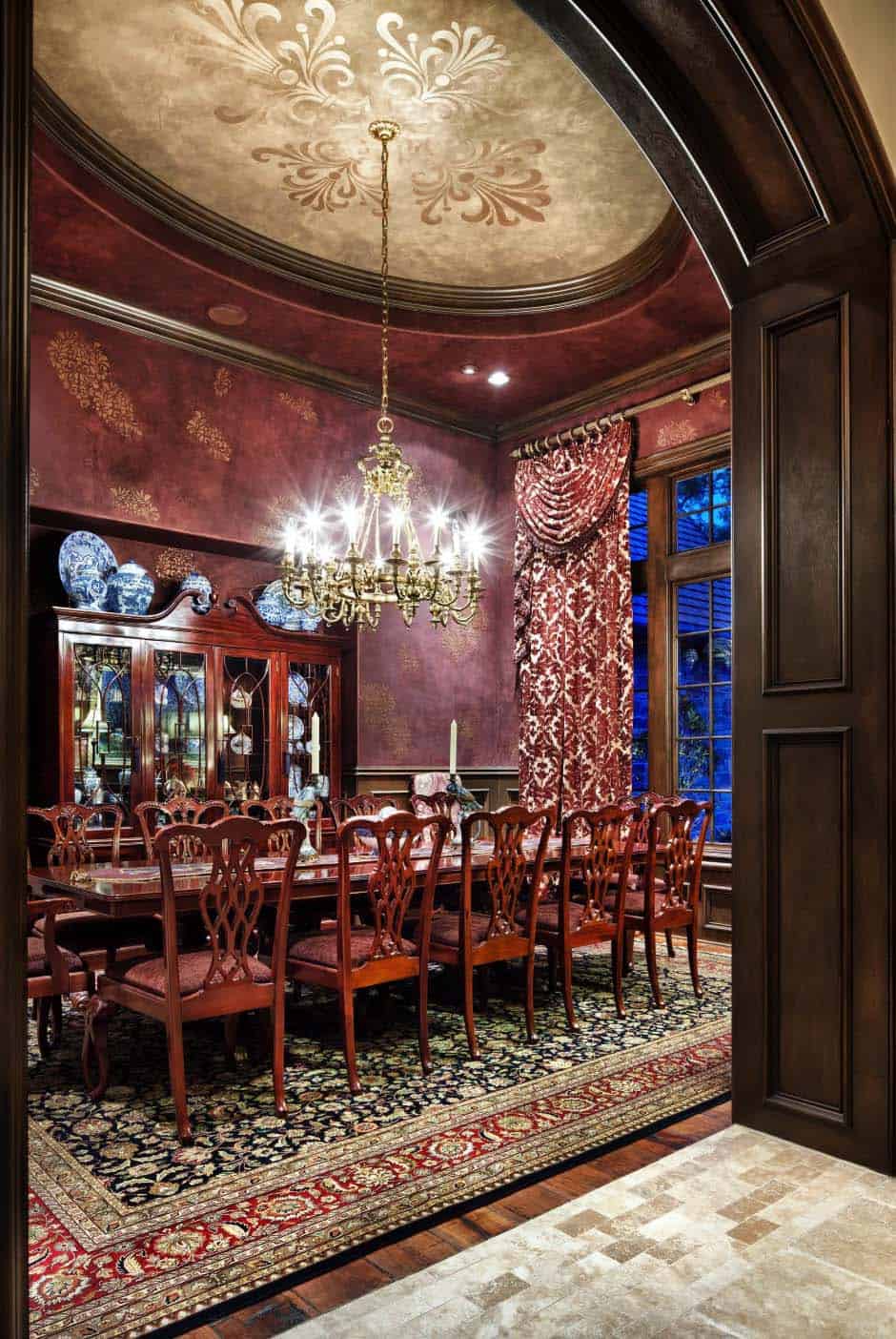 View in gallery View in gallery
View in gallery View in gallery  View in gallery View in gallery
View in gallery View in gallery Designed by Jauregui Architecture Interiors Construction the sprawling home's extravagant style is still family friendly, especially the kitchen. This space is a cook's dream, equipped with all the modern necessities, plenty of prep space and a dining space at the central island. Outdoors, the amenities include playhouse for the children and a swimming pool for the whole family. This home shows how modern convenience and comfort can co-exist with old-world grace and style.
Mobile Home

A mobile home is generally attached to utilities and is not moved frequently.
A mobile home is just that – mobile. Mind you, this type of house is not like a camper that you can move around frequently. It's actually a large trailer or pre-built structure that is used as a permanent residence.
It can be situated on a slab and connects to utilities just like a regular house. Living in a mobile home — also called a manufactured home – requires property where the home can be sited. This can be an individual plot or a location in a mobile home park.
In either case, owners are responsible for property taxes and insurance. In a park, there is a homeowners association as in other communities, and residents have to abide by rules and pay the fees to cover the upkeep of any communal areas and other services.
Tiny House on Wheels
 View in gallery View in gallery
View in gallery View in gallery While traditional mobile homes are not really designed to move around all the time, today's versions truly are. This is especially true given the explosion in popularity among tiny homes on wheels. For those dedicated to minimizing their footprint on the earth by living in a tiny house, the type on wheels is ideal for experiencing different locations.
 View in gallery View in gallery
View in gallery View in gallery  View in gallery View in gallery
View in gallery View in gallery Large or small, permanent homes or those just for get-aways, these types of mobile homes provide the main necessities in a self-sufficient way, disconnected from the world of materialism and the constant acquisition of belongings. These types of homes can connect to local power sources or they can be totally off the grid, depending on the homeowner's preferences.
Tiny home

The tiny house movement shows no sign of slowing down.
The tiny home movement has been growing across the globe for the past few years and shows no signs of dying down. These tiny residences allow people to free themselves from a lot of the expenses associated with larger homes, giving them the freedom to pursue activities other than house maintenance and upkeep.
Traditionally, these tiny houses are around 2.4 x 5 meters, which is between 100 and 400 square feet, according to Living Big in a Tiny House.
These homes generally have a sleeping loft, multipurpose central space and a small bathroom. While they do cut down on expenses, these types of houses require significant downsizing of belongings and a change in lifestyle.
Tiny Homes Fit for a Vacation
 View in gallery View in gallery
View in gallery View in gallery By definition, a small house has to be less that 400 square feet, excluding any lots. And, while you might not be ready to live in one full time, staying in one for a vacation can be a great option. These A FRAME tiny homes located in Tamarindo, Costa Rica are a great example. Generally on a trip, people are out exploring during the day and really only need a home for the night and for any relaxation.
 View in gallery View in gallery
View in gallery View in gallery 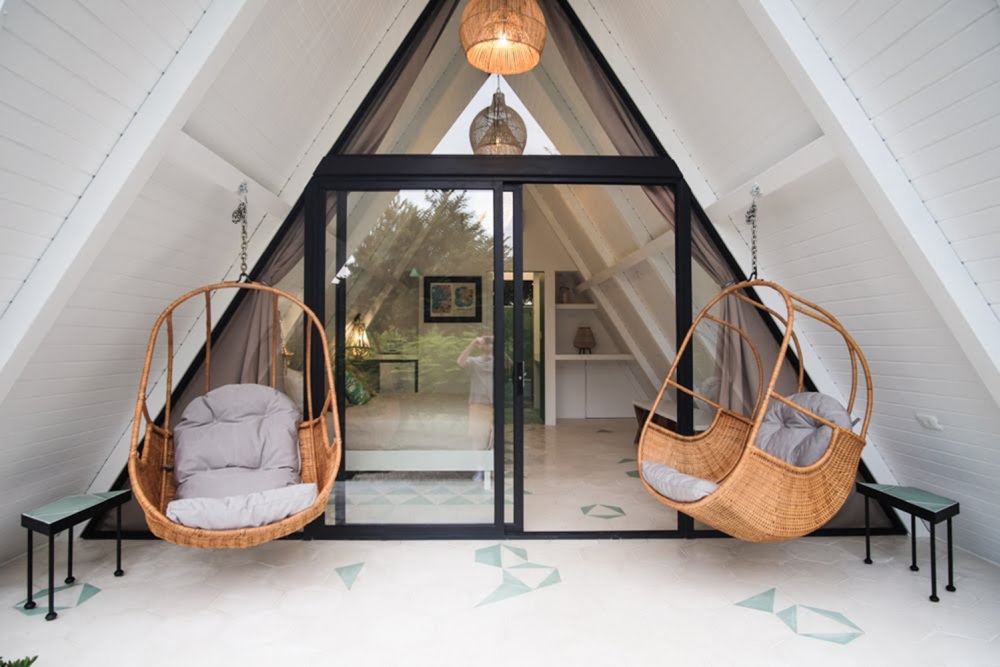 View in gallery View in gallery
View in gallery View in gallery  View in gallery View in gallery
View in gallery View in gallery Created by the Micheron Studio, these homes are done in green and white to blend with nature and a glass façade melds the interior with exterior forest. Made of prefabricated sections, assembly was easy and fast. Inside, the main space is centered around the bed and there is a full bathroom. These types of homes are increasingly popular in places like Costa Rica for their affordability as well as their sustainability.
Floating

Floating homes are permanently sited and are attached to utilities
A bit like a condo or mobile home in a park, a floating home is built on a dock-like structure and permanently connected to utilities.
The floating homeowner is responsible to pay fees for the dock and the slip, along with utilities and any other associated costs. One of the more unusual costs is the inspection that must include a diver to examine the underside.
Moreover, these types of houses have to meet all building codes and carry all the closing and other costs associated with a more traditional home.
A Floating Home That's Sustainable
 View in gallery View in gallery
View in gallery View in gallery More than just a glorified houseboat, this LilliHaus floating house is part of a line of floating homes that are produced with sustainability and traceability in mind. Created by SysHaus of Joanópolis, Brazil, the house is part of the firm's "plug&play family, which also includes a miniHaus and a nanoHaus.
 View in gallery View in gallery
View in gallery View in gallery All are produces on computer-controlled automatic machines and sent to location totally finished and ready. At 3.20 meters wide by 12 meters long, the designs have interior options and floor plans, which can be used individually or combined to form a larger unit.
 View in gallery View in gallery
View in gallery View in gallery 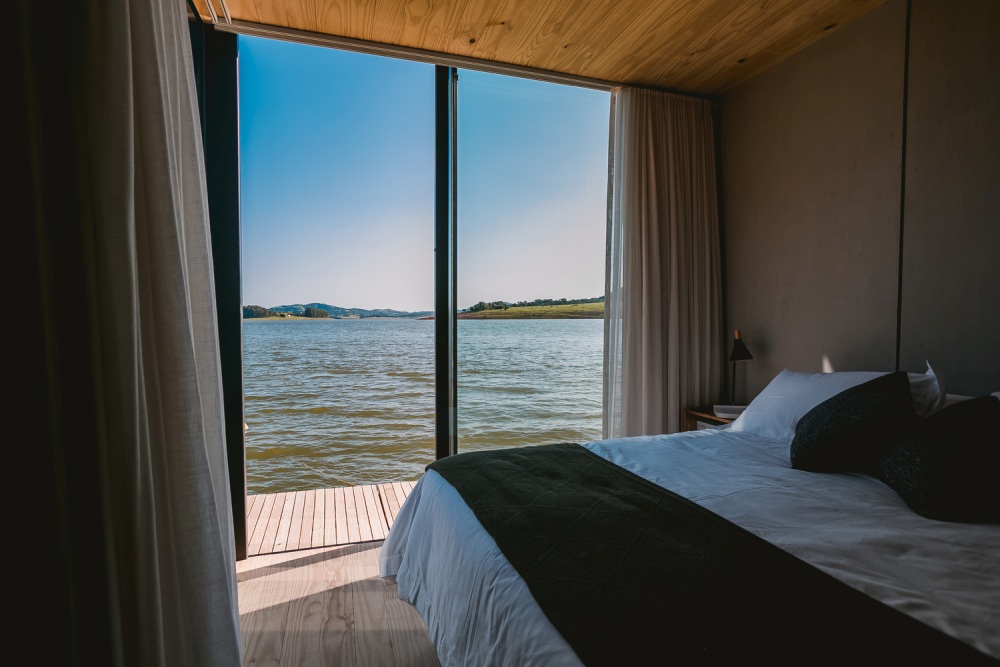 View in gallery View in gallery
View in gallery View in gallery While this one is floating, these homes can also be used on land, and, they can be on-grid or off-grid. For off-grid models like this one, solar panels are used for energy, which is stored in a battery system. All blackwater and greywater are treated in an aerobic and biological treatment station, to be returned to the environment in a state that is pure.
Tree House
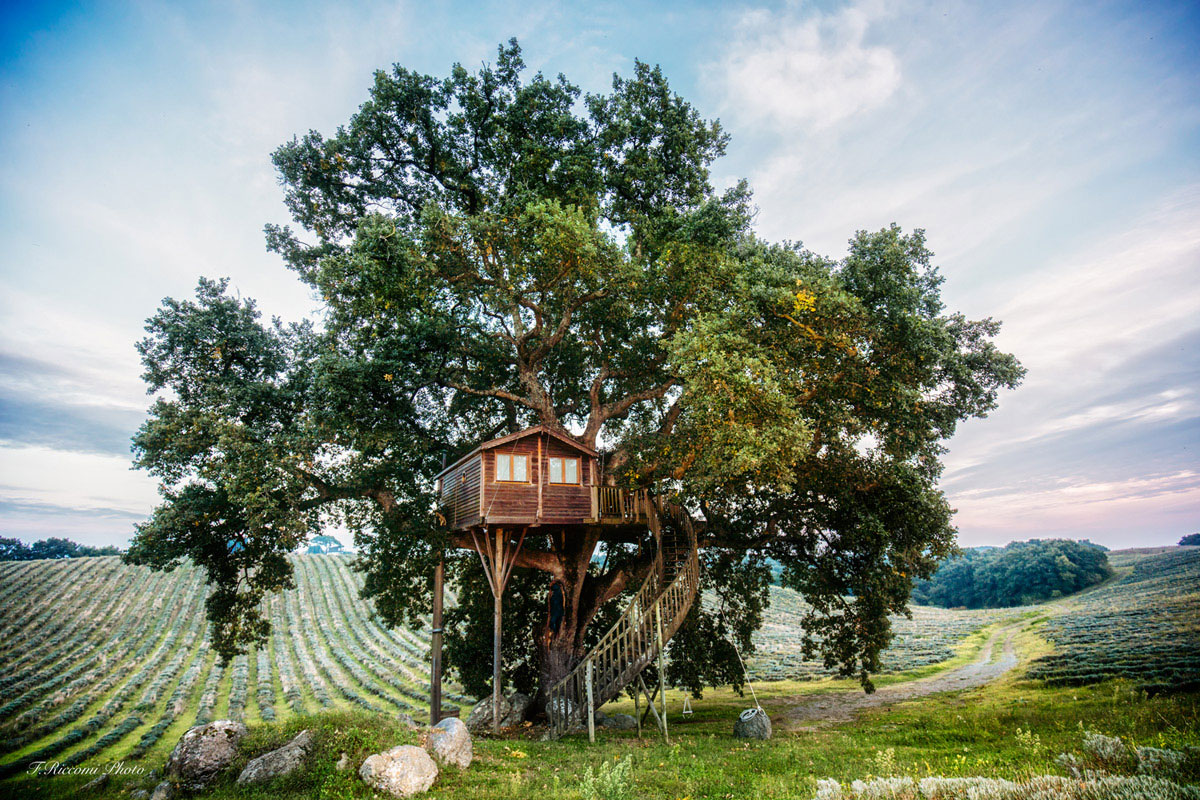
This treehouse is a get-away home in Italy.
Sure they're still built for kids in the backyard, but increasingly, homeowners looking for something more novel are turning to the trees.
Treehouses are becoming more common as primary residences or weekend getaways, especially for those who want to disconnect from technology. Much like regular homes, treehouses run the gamut from modest structures made from upcycled materials to luxurious versions designed by professional architects.
Security and privacy are among the bonuses, however, different locations will have different building codes governing whether treehouses are allowed.
This Treehouse Means Business
 View in gallery View in gallery
View in gallery View in gallery A far cry from the childhood retreat you might have enjoyed, this treehouse is all about being a sustainable model for a company retreat. Designed by baumraum architects for Sappi, the Flemish Forest and Nature Agency, the commune of Hechtel-Eksel and Proximity, the project was initiated to inspire companies to bridge the gap between economy and ecology.
 View in gallery View in gallery
View in gallery View in gallery The Treehouse is meant for companies to hold break-out sessions for collaboration and it's an ideal place for scientific research discussions and presentations. The entire treehouse is supported by 19 angled steel stilts that connect to the ground with foundation screws that make minimal impact on the forest floor.
 View in gallery View in gallery
View in gallery View in gallery The overall design is based on the concept of a sheet of paper that is pleated and wraps around both interior and exterior spaces. The treehouse encompasses two cabins on different levels, connecting terraces, a staircase and a connecting roof. The lower section has a coffee lounge, pantry, restroom and technology room, while the upper one is ensconced amid the tree tops and is meant for meetings and other events.
Yurt

Yurt living can be exceptionally sustainable.
Sustainability considerations are modernizing the image of the yurt from a 1970's phenomenon associated with hippie culture into a viable home with a smaller carbon footprint. According to the Mother Nature Network, yurt design has moved from felted wool mats to modern structures with high-efficiency glass windows, high-tech insulation, and clear translucent vinyl skylights.
With an exterior of marine-quality sailcloth, a yurt can withstand all sorts of weather. Yurts are generally built on a platform, making them quick, easy and economical to build, however, they do pose challenges for electrical lines and plumbing.
Other considerations are a lack of privacy for residents, as can close interaction with all types of nature. That said, they can be a great choice for those who like to live close to nature with fewer belongings.
Container Home

Container homes are affordable and quick to construct.
Container homes have exploded in popularity since the one of the first and most famous was built in Brisbane, Australia in 2011. Since then, people have found that these types of homes have lots of benefits besides being eco-friendly.
According to DiscoverContainers, homes made from shipping containers can cost much less than traditional homes and are generally faster to construct. On the sustainability side, each time a container is repurposed for a home, more than 7,000 pounds of steel are recycled and fewer new building materials are used.
Houses made from shipping containers range from modest, off-the-grid homes to luxurious constructions with several containers joined together.Container
Container House by Plannea Arquitectura + Constanza Domínguez C.
 View in gallery View in gallery
View in gallery View in gallery Repurposing shipping containers is another sustainable way to create a home or multi-function space. Plannea Arquitectura of La Compania. Chile, created this unique structure, which is made of two containers connected by a large roof. The wide space between can be an extension of the house in the daytime or be used as a workshop, yoga space or other exercise area. However it's used, a container home can help forge a closer relationship with nature and make a smaller footprint on the earth due to the repurposed containers.
 View in gallery View in gallery
View in gallery View in gallery  View in gallery View in gallery
View in gallery View in gallery  View in gallery View in gallery
View in gallery View in gallery  View in gallery View in gallery
View in gallery View in gallery These homes are inexpensive and fast to construct. By adding a second container, the architects were able to create two bedrooms and a bathroom inside. Set amid a quiet landscape of rolling hills and protective tree, the home is a place of solitude and relaxation. The slated roof that covers the entire space is more than just a shelter: It creates a thermo-regulation system because of its design. Finally, the wood cladding adds warmth to counter the expanse of steel and forges a connection with the natural surroundings.
Cave

Cave homes have a number of advantages over traditional houses.

A small portion of the home is visible outside the cave.
Caves might have been the earliest type of housing, but they can still serve as homes for people today. In fact, for those who want to minimize the impact they have on the environment, cave homes are a popular option, writes Earth Homes Now.
From a practical standpoint, cave homes are a good idea: They are quiet, secure, maintain a constant temperature and are well protected against the elements and storms.
That said, a natural cave is probably too small for a family home, so it will either need to be excavated further or the cave will need to be created artificially. Regardless, these types of homes have some definite advantages.
Photocatalytic Cave
 View in gallery View in gallery
View in gallery View in gallery This unusual residence will change any preconceived ideas you might have had about living in a cave. Located west of Mexico City, Mexico the Photocatalytic Cave is 12 meters below a house in the upper part of a hill in an area where sand was extracted, Designed by Amezcua architects, this unique home needed a number of things to make it habitable: a secure structural framework, a roof tall enough and physically able to distribute load forces, and proper water runoff. In addition, humidity mitigation systems were created.
 View in gallery View in gallery
View in gallery View in gallery  View in gallery View in gallery
View in gallery View in gallery  View in gallery View in gallery
View in gallery View in gallery  View in gallery View in gallery
View in gallery View in gallery Inside, past the entrance hall is a kitchen and a dining room able to accommodate 12 people, along with a living room whose sofas was crafted to follow the curvature of the wall. There is also a gallery featuring a wine cellar and coffee area, along with a bathroom, where the washbasin is a focal point, having been manufactured on-site with marbled concrete, cast with a special formwork that refers to the strata of the cave, by the artist Rodolfo Díaz Cervantes of Taller Tornel.
Underground Homes

They may look like a hobbit house, but underground homes are very comfortable.
Underground homes have generally been in the realm of doomsday preppers and fodder for late night comedy, but they are actually an efficient – and popular – way to live. Earth Homes Now says that in the US, there are already more than 6,000 underground homes.
These types of homes are not just for people awaiting the apocalypse. Those who want to be more eco-friendly like these homes because they don't use as many natural resources. They are safe in natural disasters and are more energy efficient because they are underground.
Underground homes also require very little exterior maintenance because at most, one wall of the home is exposed Styles of building underground homes can range from earth berms, rammed earth, urban sites, shafts, tunnels and even abandoned underground nuclear missile silos.
As always, different types of houses have advantages and disadvantages, and not every kind will be suitable for every person. This just provides an overview of the breadth of selections available when considering a home.
Determining the lifestyle you want to lead and the priorities you have will help guide you to the type of house that will be the most appropriate.
Different Types of Houses Pictures and Information
Source: https://www.homedit.com/types-of-houses/